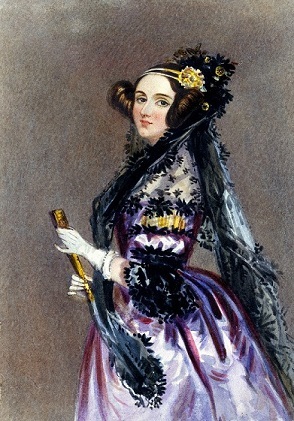Ada Lovelace/en

| ||
|---|---|---|
| Ada, Countess of Lovelace, 1840 | ||
| Born | 10 December 1815 | |
| Birth place | London, England | |
| Died | 27 November 1852 (aged 36) Marylebone, London, England | |
Augusta Ada King, “Ada Lovelace” (10th december 1815 - 27th november 1852) was an English writer known worldwide for describing Charles Babbage’s analytical engine.
Biography
Ada was deeply educated in Maths and Music. In this way, she tried to develop her rational and objective skills, in order to set them aside from the emotional and subjective skills that were supposed to feed Poetry. Even so, her life was a constant struggle between reason and emotion, objectivism and subjectivism, Poetry and Maths.
Studies
When Ada met Mary Somerville, a renowned author and scientist from the XIX century, she introduced her to Charles Babbage, the lucasian professor of Maths of the University of Cambridge (and father of the computers). Then, when Ada was only seventeen years old, a huge correspondence started between them, about subjects related mainly with Mathematics and Logic. Charles Babbage was so impressed by the analytic capacity of young Ada that he nicknamed her “The Enchantress of Number”.
Professional life
Ada Lovelace started to work with the English mathematician and scientist Charles Babbage at the age of eighteen. The man who invented the first computer was impressed with the manner in which Ada Lovelace understood the working of his analytical engine and she started to work with him, firstly as a disciple and later as a collaborator. However, during the Victorian era it was not well looked upon that a woman was involved in subjects of that nature. That was the reason why Babbage only named Ada in his publication as a simple transcriptor. The analytical engine in which they both worked on was thought to be programmed for executing different algorithms and solving any kind of problem. While she was carrying out those tasks, Ada conceived something that she would later name “a plan”, capable that the machine invented by his tutor could be reconfigured for calculating Bernoulli’s numbers through the usage of perforated cards. Actually, this “plan” is considered as the first computer programme, and for that, Ada Lovelace is known as the first person who described a programming language, even a hundred years before the first computer was invented. Ada Lovelace contributed to Computer Science concepts as “loop” (group of instructions that are executed several times) or “subroutine” (part of a program that can be invoked when it is needed). Conscious that her contributions will not be appreciated until many years later, Ada Lovelace gathered her notes, enriched them with demonstrations and analysis and published them with the initials A.A.L. She wrote a paper which included demonstrations about how to calculate trigonometric functions with variables and the needed programs to work them out in the analytical machine.
Acknowledgements
The programming language Ada, created by the Defense Department of the United States, was named after Ada Lovelace. The reference manual of the language was approved the 10th december 1980, and the Defense Standard of the United States for the language MIL-STD-1815 was given the number of her year of birth. After 1998, the British Computer Society has awarded with the Lovelace Medal in her name and in 2008 they started an annual competition for Computer Science female students. In the United Kingdom, the BCSWomen Lovelace Colloquium (annual conference for female undergraduates), also has her name. The Ada Initiative is a nonprofit organisation dedicated to incrementing the participation and dedication of women in free culture and open source. Ada Lovelace also has her own day in the calendar: the 16th october. This day pays tribute to all those women around the world who had contributed with effort and few praises in the fields of Science, Technology, Engineering and Maths.